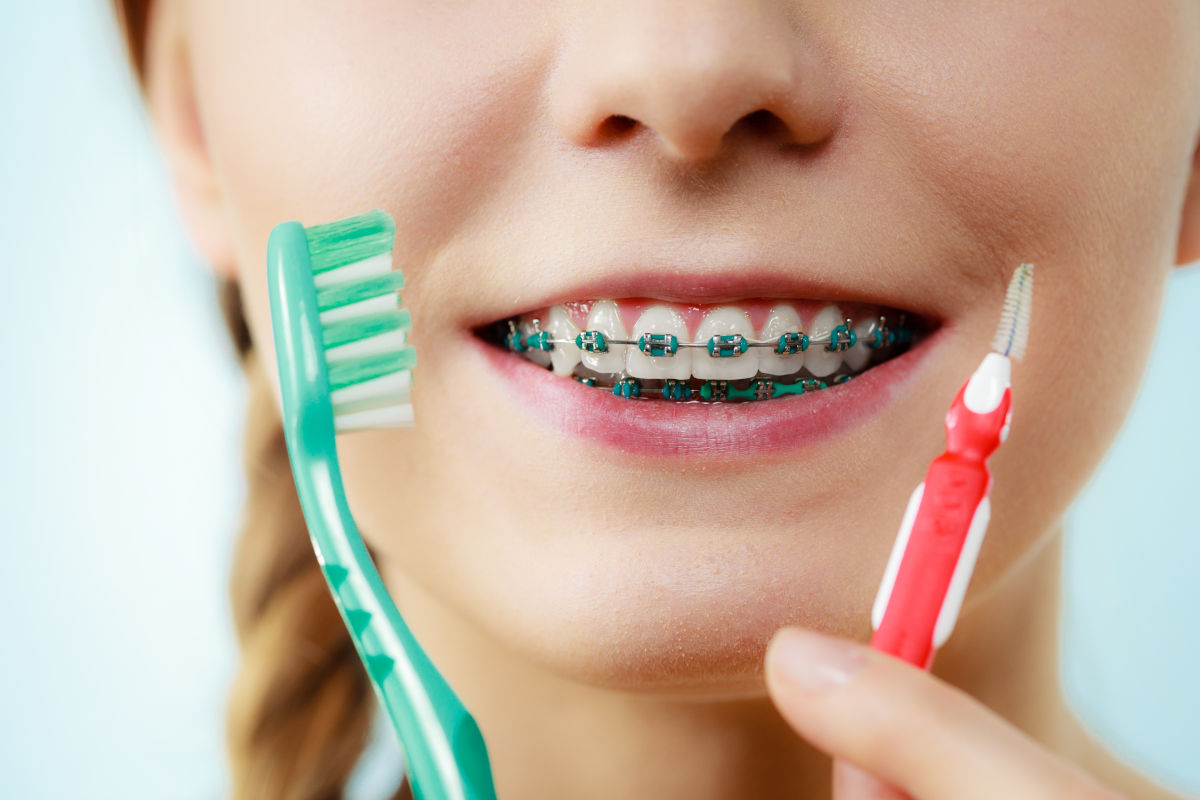Contents

How to Properly Brush Your Teeth with Braces
Wearing braces requires relearning how to brush your teeth. It takes some time to get used to the brackets and wires and to find the right technique to effectively clean the teeth and interdental spaces. Impeccable oral hygiene is crucial during orthodontic treatment to prevent cavities and other problems.
This article explains how to properly brush your teeth with braces and presents the best products to optimize your dental hygiene throughout your treatment.
What is the Brushing Technique to Adopt with Braces?
Brushing your teeth with braces is quite similar to regular brushing. However, you need to be extra thorough and gentle to avoid injury or damage to the appliance. Here's how to do it:
- Rinse your toothbrush and apply your usual toothpaste.
- Hold the brush at a 45° angle to your gum line.
- Make circular movements around the appliance and on your teeth.
- Clean each surface of every tooth, for about 2 minutes in total (30 seconds per quadrant).
- Use an interdental brush to clean between the teeth and under the wires.
- Brush your tongue for fresh breath.
- Rinse your mouth.
Electric toothbrushes are particularly effective at removing plaque from orthodontic appliances.
How to Use an Interdental Brush with Braces
This tool complements brushing by reaching areas inaccessible to a regular toothbrush. Its use is often easier than flossing with braces. To use it:
- Gently slide the brush between the brackets.
- Make up-and-down movements on each side of the brackets.
- Gently pass it along the wires.
- Rinse the brush after use.
- Replace it as soon as it wears out.
A Few Additional Tips
- Rinse your mouth with water before brushing to dislodge food debris.
- Avoid whitening toothpastes and mouthwashes, which could create color disparities.
- Use a water flosser before brushing (not after, to avoid washing away the benefits of the toothpaste).
When to Start Brushing After Getting Braces?
Despite the unpleasant sensations felt right after the braces are put on, it is crucial to establish a dental hygiene routine from the very beginning of the treatment. You can eat normally and brush your teeth without fear of the brackets coming off, as orthodontists use a strong adhesive. Start brushing your teeth after every meal as soon as your appliance is placed.
How Often Should You Brush Your Teeth with Braces?
With or without braces, it is generally recommended to brush your teeth twice a day. However, during orthodontic treatment, you should also clean your teeth after every meal. Many patients do a more thorough brushing in the evening to go to bed with a perfectly clean mouth and prevent bad breath. Daily use of dental floss or interdental brushes is also essential.
Which Toothbrush to Choose During Orthodontic Treatment?
The key is to opt for a soft-bristled toothbrush, whether manual or electric. Some toothbrushes are specially designed for cleaning orthodontic appliances, such as:
- The TePe Orthodontic Toothbrush, with its triangular head and two rows of bristles (about $4).
- The Y-Kelin U-shaped brush, perfect for cleaning around wires and brackets (pack of 4 for $10).
- The GUM brush with a compact V-shaped head that fits the archwire (about $5).
Dental Hygiene Kits for Braces
For even more convenience, you can opt for a special braces hygiene kit that includes all the necessary tools for optimal hygiene. This is the case with the TePe kit (about $10), which contains:
- 1 "Supreme Compact" toothbrush with bi-level bristles.
- 1 "Compact Tuft" brush with a special head for precise cleaning around brackets.
- 2 interdental brushes for cleaning between teeth and under the wire.
- 1 travel pick for easy interdental access.
- 1 orthodontic wax to protect the mucous membranes.
In Summary, to Take Care of Your Teeth with Braces
| To Do | To Avoid |
|---|---|
| Brush for at least 2 min after each meal | Neglecting your oral hygiene |
| Use a soft-bristled brush (regular or special for braces) | Brushing too hard and damaging the appliance or gums |
| Supplement brushing with interdental brushes | Using whitening products |
Rigorous dental hygiene is the key to the success of your orthodontic treatment. Equip yourself with the right tools, be consistent in your routine, and don't hesitate to ask your practitioner for advice. Your efforts will be rewarded with a beautiful smile at the end of your treatment!
FAQ About Brushing Teeth with Braces
Can you use an electric toothbrush with braces?
Yes, electric toothbrushes are even very effective at removing plaque from brackets and wires. Choose a model with a mode dedicated to orthodontic appliances if possible.
How do you clean a removable appliance?
Brush your removable appliance morning and evening with a soft-bristled brush and toothpaste. Rinse it after each meal. You can also soak it regularly in a cleaning solution sold in pharmacies.
My teeth hurt after brushing, is this normal?
A slight sensitivity is common at the beginning of the treatment as your teeth get used to the appliance. If the pain persists, talk to your orthodontist, who can check the adjustment of the brackets and wires.
Should I brush my teeth longer with my braces?
The recommended brushing time is still 2 minutes, but you do need to be more thorough to clean well around the brackets and under the wires. So, plan a few extra seconds to make sure you don't miss anything!
How do I know if my dental hygiene is sufficient?
Your orthodontist will check the condition of your teeth and gums at each appointment. If you notice white spots appearing on your teeth or if your gums bleed abnormally, your hygiene is insufficient. A little extra effort may be needed!
